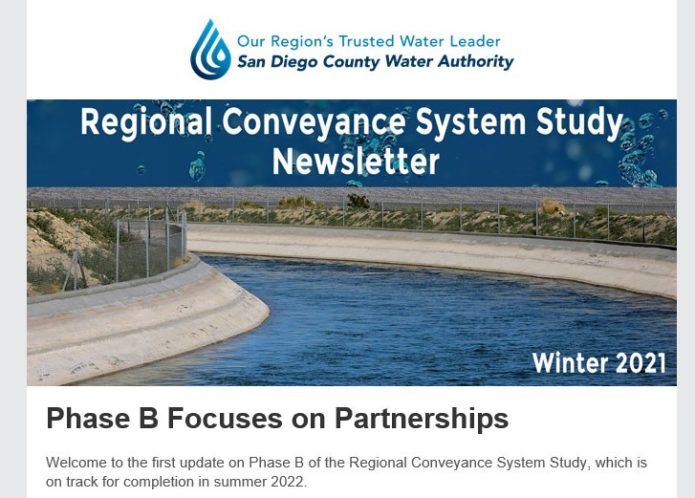
To help keep the San Diego region, Imperial Valley and other interested stakeholders informed on the San Diego County Water Authority’s feasibility study of a proposed new aqueduct to transport 280,000 acre-feet of Quantification Settlement Agreement supplies (QSA), the Water Authority has launched a newsletter with the latest updates on the study. Today, the readers of this blog (Imperial-San Diego Currents), which is published by the Water Authority, will be receiving the first publication of the newsletter. Look for it in your emails.
For background, the 280,000-acre feet of QSA supplies includes the water transfer agreement between the Water Authority and Imperial Irrigation District (IID) for 200,000 acre-feet of water conserved in the Imperial Valley through on-farm and system conservation, which is funded by the Water Authority, and 80,000 acre-feet of water conserved through the lining of the All-American and Coachella canal, projects paid for by the Water Authority and a state bond. The QSA supplies have ramped up to their full amount this year.
The Regional Conveyance System Study, which considers an aqueduct sized only to convey the existing QSA supplies, is now in its second phase, Phase B. Phase B is expected to be complete in summer 2022 and delves deeper into the technical and economic feasibility of the proposed aqueduct as well as potential partnerships, exploring the multi-faceted benefits of the proposed project to stakeholders throughout the Southwest, including in the Imperial Valley. Phase A of the study, completed in August 2020, showed that a direct aqueduct between the Imperial Valley and San Diego could be a more cost-effective way in the long term to transport QSA supplies rather than paying Metropolitan Water District of Southern California (MWD) to move those supplies through its Colorado River Aqueduct. The agreement with MWD ends in 2047 and has no provision that would allow for an extension unlike the water transfer agreement between IID and the Water Authority that allows for an extension if both parties agree. Phase A also looked at potential benefits in the Imperial Valley, focusing, for one, on storage through a joint use reservoir in the Valley that would be needed to help regulate the flow of water into the proposed aqueduct but that could also enhance water deliveries to farms. Additionally, Phase A considered support for the Salton Sea through an annual brine stream from a treatment plant being considered as part of the project that could create new habitat at the sea and through potential renewable energy development that could help meet the project’s power needs. These concepts would be further looked at in Phase B.
Throughout Phase B, transparency and engagement is critical, both to ensure stakeholders have access to the most up-to-date information, and to seek input and feedback on the components of the study. The newsletter represents one way to reach out to stakeholders. This website—Imperial-San Diego Currents—with its water blog and “Ask Darren” section, represents another way to obtain information and ask questions. The Water Authority is also available to give presentations on the study upon request. If interested, contact QSA Outreach Coordinator, Darren Simon at dsimon@sdcwa.org or call his Imperial Valley office at 760-337-1386.
It is worth emphasizing that the Regional Conveyance System Study is just a feasibility study—the Water Authority Board of Directors will face a decision at the end of Phase B in summer 2022 on whether to advance the study to the next phase. Between now and then, expect updates and feel free to reach out with questions. As with the study of any large, generational project, the Regional Conveyance System Study has and will likely continue to generate lots of questions and a great deal of discussion worth having. Only through such discussions among all stakeholders can informed decisions be made. Stay tuned for more to come and look for that first edition newsletter.
Thank you for continuing to read this blog.
